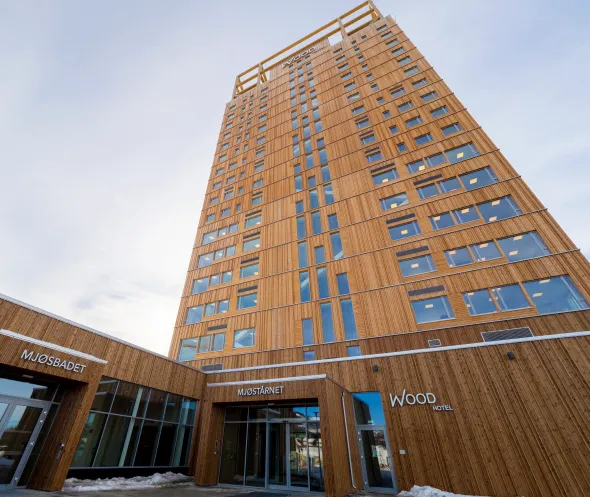Mjøstårnet: the world’s highest timber building opens in Norway
The revolutionary use of PEFC-certified timber in its construction and cladding makes the tower an internationally renowned signal building.
Mjøstårnet: the world’s highest timber building opens in Norway
15 July 2019 Construction
At a remarkable 85.4 metres, Mjøstårnet is the world's tallest timber building. Opened only this spring, it has already attracted a lot of attention both in Norway and abroad.

Mjøstårnet is a modern mixed-use tower. On its 18 floors, there are rentable meeting rooms, five floors of office space, 72 hotel rooms and 33 apartments. Its combined floor area is around 11,300 square metres.
Mjøstårnet is located in Brumunddal, in the north of Oslo. Standing alone on a river bank, the tower has a majestic appearance, overlooking Norway’s largest lake, which also gave it its name: ‘Mjøstårnet’ is Norwegian and means ‘The tower of Lake Mjøsa’.
With its distinct architectural appearance, Mjøstårnet is a signal building, not only in the way it stands out in the landscape, but also because of the revolutionary use of timber in its construction and cladding.
An extraordinary construction process

Mjøstårnet was designed by Voll Arkitekter and constructed by Hent AS and Moelven Limtre AS. The building was assembled in five construction stages, four storeys at a time, and without external scaffolding.
The PEFC-certified glulam structure was first assembled on the ground next to the building, before being hoisted up.
“The most interesting part in the building process was the assembling,” Rune Abrahamsen, CEO of Moelven Limtre, told Metsä
Before the project, large pieces of timber constructions were pre-assembled in the Moelven factory to make sure that everything fit. Then piece by piece was moved to the building site and installed directly into the building.
A special building material

Glue-laminated timber (glulam) is made with multiple layers of solid wood lumber bonded together with glue to form strong columns and beams.
Flexible and strong at the same time, glulam can be moulded into different shapes, such as arches, but also form the main structure of a building, just as concrete and steel. In addition, glulam is cost-effective and fire resistant.
Wood stores CO2 throughout its life cycle. Wood from sustainably managed forests is the only renewable building material available on the planet on a large scale. As the glulam production process requires very little energy, buildings with load-bearing structures in glulam have a very low carbon footprint.
Photo credits: Voll Arkitekter (1,2), Moelven Limtre (3)